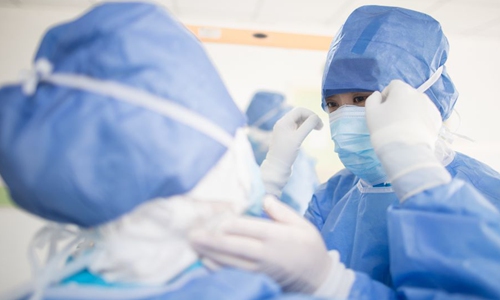HOME >> SOURCE
China's investment in medical care is insufficient: economist
Source:Global Times Published: 2020/2/24 20:13:41 Last Updated: 2020/2/25 2:59:37

Medical workers wear protective suits and equipment before entering the isolation ward at Wuhan No.1 Hospital in Wuhan, central China's Hubei Province, Feb. 22, 2020. (Xinhua/Xiao Yijiu)
The onslaught of the novel coronavirus has incurred trillions of yuan in losses for the Chinese economy, and China needs to spend 200-300 billion yuan to improve its public health system in the coming five years, said Huang Qifan, an influential economist and former mayor of Chongqing city.
He believed that the outbreak of coronavirus exposed "systemic problems in China's existing public health system" and forced the nation to strengthen all-around reforms in public health by enlarging the input of government investment, medical facilities and talent training.
He believes China should invest more into the health sector, noting that China's public health investment at the moment is insufficient.
While China's GDP increased 240 times after 40 years of reform and opening up, the number of hospitals nationwide only increased 3.55 times from 9,293 in 1978 to 33,009 in 2018.
In 2018, China's public health expenditure was 1.6 trillion yuan, accounting for only 1.7 percent of the GDP.
He noted there is huge room for improvement in China's medical care system as the allocation of medical resources in small and medium-sized cities is insufficient and the medical facilities and treatment quality is uneven.
In addition, in many hospitals, doctors and nurses are understaffed. By the end of 2018, the total number of health practitioners in China was 12.3 million while that in the US is 19 million.
He believed China must increase the input of high-quality equipment in government-led medical institutions and expand talent training in public health and epidemic prevention personnel. Key universities should be encouraged to establish public health colleges.
Huang suggested China appropriate more fiscal investment from infrastructure projects to the health sector as the latter has a higher turnover and can better boost GDP to promote sustainable and high-quality development.
According to past experience, only 30 percent of the financial investment in railway and highway infrastructure is converted into the GDP per year while 60 to 70 percent of investment in public services and facilities such as education and health can be converted into the GDP per year.
"As long as we have a workable plan and a strong implementation mechanism, this investment will be a sign that China's economy has entered high-quality development. Through this improved medical care system, we can prevent problems before they occur, and try to avoid the emergence of infectious diseases such as SARS and COVID19 in the future," he said.
Posted in: ECONOMY